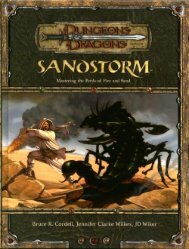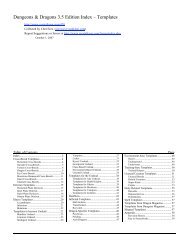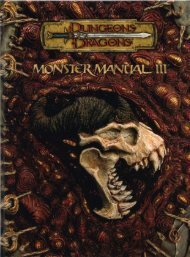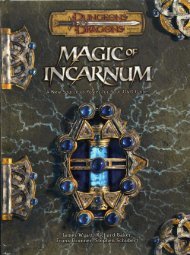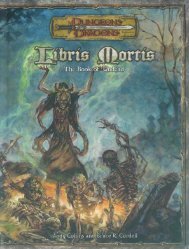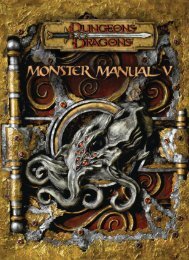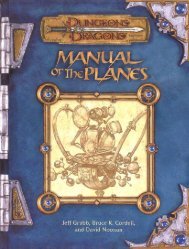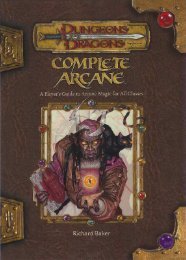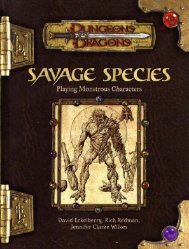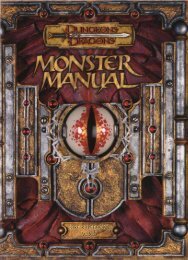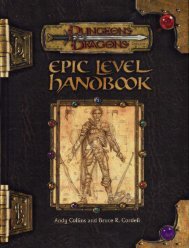CHAPTER 2HALFLINGS42halfling can take hours to tell and provide entertainmentfor a whole clan.THE SHORT-TERM VIEWThough halflings have longer life spans than humans do,they are still short-lived creatures compared to races such asthe elves. Thus, halflings tend to take a short-term view inmuch the same way that humans do. They are, however, morecareful to ensure their future welcome than humans tend tobe, and more careful with the environment than half-orcs are.Still, halflings take no pains to ensure the sustainability <strong>of</strong>their communities because they rarely stay in one place forlong. They take what they can from the environment, andthen simply leave should it become unable to support them.They do not plant trees to replace those they have cut, or sowcrops to replace those they eat. Halflings take no more fromthe land than they need and leave it to nature to restore anyarea they have used.OPENNESS AND SECRECYHalflings are known for their gregarious nature and open,friendly attitude toward strangers. Unless he or she presentsan obvious danger, a traveler <strong>of</strong> any race approaching a halflingcamp or settlement can expect a hearty welcome andan invitation to share fire, food, and ale. Such impromptumeetings are usually replete with stories, songs, and merriment.Reflecting on the conversation later, however, a strangermay come to realize that the halflings said almost nothing<strong>of</strong> importance about themselves. In fact, almost anyone whohas extended contact with halflings has a nagging sense thatthey are holding something back.Halflings have developed content-free conversation toa fine art. Although they speak readily and openly withstrangers about most topics, they artfully turn aside questionsfrom outsiders about their clans, homes, customs, families,and other personal matters. Such secrecy has developed inhalflings over many generations as a defense mechanismto prevent disgruntled “clients” and enemies from trackingdown specific halflings. Though a halfling may spin a longand amusing tale about a hapless relative, the listeners are<strong>of</strong>ten amazed to realize later that they have no clue at all abouthow to find or identify the person who was lampooned inthe story.HALFLING TRAITSPart <strong>of</strong> the reason why halflings prefer to spend their liveson the road is their unflagging curiosity. They simply mustsee what’s around the next bend—and the next, and thenext, and the next. A halfling greets each new day withan excitement rarely found among humans because sherecognizes it as a new opportunity for adventure—and anopportunity not seized is an opportunity lost. Halflingsare cunning enough to recognize tricks the majority <strong>of</strong> thetime and are rarely taken in by them, but even so, many goalong with a trick anyway, just to see what’s coming next. Ahalfling can’t stand the idea <strong>of</strong> an unexplored cave, a closeddoor, or a locked chest—he simply has to see what’s inside.Poking his nose into places he hasn’t been invited maysometimes be a mistake; at other times, doing so might bringwealth, new friends, or opportunities for adventure. Indeed,halflings prefer activity to waiting and trouble to boredombecause doing something is always more interesting thandoing nothing.Though halflings do not act stupidly when danger threatens,they exhibit little fear <strong>of</strong> death or the unknown. Death is butthe next great adventure, and the unknown is just as likely tocontain fabulous riches as grave danger. This combination <strong>of</strong>curiosity and fearlessness makes them difficult companionsfor those <strong>of</strong> more careful races. Often the members <strong>of</strong> anadventuring party find that while they have been talkingabout options, their halfling companion has already openeda door and made their discussion moot.Despite their apparently impulsive nature, halflings canfocus intently on tasks requiring concentration. Whether sheis mending a weapon at a forge or picking a lock, a halfling’sfocus on a task she wants to accomplish is as strong as that<strong>of</strong> any other race.A high level <strong>of</strong> activity is characteristic <strong>of</strong> most halflings.Charged with energy, they can barely sit still. Restlessnessseems to radiate from their bodies, and they are prone totwitching, fidgeting, and other physical indications <strong>of</strong> theneed to move about. Halflings who embrace the path <strong>of</strong> therogue learn to mediate such responses to a degree for thepurpose <strong>of</strong> stealth, but most retain their zest for activitythroughout their lives.Though they are not overly greedy, halflings enjoy accumulatingwealth just as much as humans do. They spend little<strong>of</strong> what they amass, preferring to save most <strong>of</strong> it to ensure acomfortable retirement or a steady supply <strong>of</strong> food for theirfamilies. Still, they enjoy the sight <strong>of</strong> gems, the gleam <strong>of</strong>gold, and especially the joy <strong>of</strong> finding out what a new magicitem does. Many halflings incorporate magic items they havefound into entertainment for their clans, creating illusionsor disappearing into thin air at just the right moment.Halflings are mindful <strong>of</strong> the needs <strong>of</strong> the group as wellas those <strong>of</strong> the individual; neither is more important all thetime. Sometimes an individual’s needs must outweigh those<strong>of</strong> the group, especially if the person is deserving or talented.At other times, the clan’s welfare takes precedence. Halflingshave a talent for evaluating situations and making judgmentswithout being hampered by the prejudices that the clannishdwarves or the self-indulgent elves commonly display.The highest virtues for a halfling are an adventurous spirit,a willingness to work, and a strong commitment to familyand friends. Halflings who go adventuring are consideredheroes because they bring back both wealth and—moreimportantly—stories.Roleplaying Application: Halflings are well suited foradventuring, given their wanderlust, their curiosity, their lack<strong>of</strong> fear, and their strong need for new experiences. Halflingswho leave their clans to adventure are not only welcomedback but celebrated as heroes when they return.
Halflings are usually pleasant traveling companions,though their penchant for trouble tends to cause occasionalannoyance in their companions. However, they understandhow adventuring parties must work together, and they arequite able to respond to threats against their companionswithout becoming distracted.Though all halflings are curious, active, trouble-prone, andfearless, other aspects <strong>of</strong> an individual character require somedefinition. What is your character’s personality like? Doesshe come from a caravan or a settlement? How do her friendsand family back home view her? Does she feel the need toprove herself, or is she just out for treasure and adventure?HALFLING LIFEMost outsiders believe that halflings lead a happy-go-luckylife, free from cares and responsibilities. As is <strong>of</strong>ten the case,however, the truth is quite different. Though having minimalpossessions does avoid many <strong>of</strong> the problems faced by moresettled folk, halflings must endure cold, rainy nights, hungerwhen food is scarce, attack by monsters in the wilderness,wagons stuck in the mud, rocky trails, and a general lack <strong>of</strong>privacy. The fact that they can face such difficulties and stillwear the carefree smiles that most people associate with themis a tribute to the halfling spirit.Halfling culture is not as old or as developed as that <strong>of</strong> theelves, but its diversity provides a richness <strong>of</strong> its own. Like aquilt sewn by many hands, halfling culture is a patchwork<strong>of</strong> different styles, arts, and attitudes. Though most halflingsespouse the same general principles, each caravan (or sailingship, for seafaring halflings) forms a subculture <strong>of</strong> itsown, with particularcustoms, rules<strong>of</strong> behavior, rituals,and even speechpatterns. Halflingsrecognize this diversityand are alwayseager to learn the customs<strong>of</strong> others <strong>of</strong> theirkind. The constantturnover amongthe people in a givencaravan ensuresthat each subculturecontinues togrow and evolve.Most halflingsadopt noncombatpr<strong>of</strong>essions such asblacksmith, animal herder,or some other function withinthe caravan. A high percentage leavethe caravan at some point to take up adventuring. The halfling’sneed to see what’s around the next bend or behind the nextdoor is never served as well as in an adventuring career.ARTS AND CRAFTSLike humans and dwarves, halflings usually specialize incrafts and pr<strong>of</strong>essions, with each person occupying a necessaryniche in the community and providing a particularservice throughout his life. Each caravan has a blacksmith,a wheelwright, a wagon builder, a butcher, various cooks,hunters, animal trainers, spinners, weavers, priests, tinkers,jewelers, and general laborers. Nearly all halfling NPCs ina caravan specialize in one primary skill and take one ortwo ranks in several others that they have developed in casesomeone needs to fill in for another member <strong>of</strong> the caravanwho has become ill or disabled. Such secondary skills alsostand halflings in good stead when they camp near otherhumanoid communities and hire themselves out.Crafts are the primary outlet for a halfling’s creative side.Halflings create very little art for its own sake; there is usuallylittle money in such endeavors. Why spend weeks making alovely painting or statue that will have to be carried aroundfor months and months, taking up valuable space in someone’swagon? Better to carve and paint children’s toys and sell themat the next stop. Halflings do, however, enjoy embellishingthe items they use in daily life. Some paint designs <strong>of</strong> remarkablebeauty on the sides <strong>of</strong> their wagons; others make jewelryor embroider clothing for their own use. Such use <strong>of</strong> one’screative abilities is beneficial to both the individual and thecommunity. Brightly colored wagons can draw attention fromother humanoids, attracting them to the camp, so the halflingscan easily transact business with them. Likewise, strikingclothing and jewelry sometimes speaks more <strong>of</strong> prosperitythan <strong>of</strong> a vagabond lifestyle, which tends to put more stablebusinesspeople at ease.Textiles, fashion design,metalwork, jewelry making,weaponsmithing, armorsmithing,woodworking,pottery, and other such endeavorsare all considered viableexpressions <strong>of</strong> one’s artisticself, and even painting hasits place when used forthe embellishment <strong>of</strong>otherwise utilitarianobjects or for pr<strong>of</strong>it.Skill at architectureis nearlyunknown amonghalflings, becauseso few <strong>of</strong> them buildpermanent structures.A halfling merchant uses her wagon to display her craftworkMusic is an art form thatevery halfling can appreciate. Itnot only helps to bring in coin butalso lifts the spirits after a long, hard day <strong>of</strong> travel. It providesthe framework for dancing, an indulgence <strong>of</strong> which halflingsare particularly fond. Only when the need for silence is greatIllus. by E. FiegenschuhCHAPTER 2HALFLINGS43
- Page 2: C R E D I T SD E S I G NSKIP WILLIA
- Page 7 and 8: no elf could predict which memory w
- Page 9 and 10: premium. Thus, each individual can
- Page 11 and 12: The elves have raised one form of e
- Page 13 and 14: do spend time away from one another
- Page 15 and 16: espects during this time, and those
- Page 17 and 18: Stores Master: Charged with keeping
- Page 19 and 20: would be the birthright of any full
- Page 21 and 22: of feet above the forest floor. Mos
- Page 23 and 24: Cleric Training: More than any othe
- Page 25 and 26: ELF HISTORYAND FOLKLOREThe elves cl
- Page 27 and 28: along with her son Hionyron, who wa
- Page 29 and 30: and return her to her people.” In
- Page 31 and 32: Table 1-3: Suffixesd% Suffix Meanin
- Page 34: CHAPTER 1ELVES34tri-level tree home
- Page 37 and 38: Illus. by C. Lukacsurious and activ
- Page 39 and 40: the reason for the farmer’s hospi
- Page 41: Halflings make a visitor feel welco
- Page 45 and 46: Halflings are as eager to experienc
- Page 47: A chief or elder heads each clan, c
- Page 50 and 51: CHAPTER 2HALFLINGS50away from their
- Page 52 and 53: CHAPTER 2HALFLINGS52Illus. by S. Wo
- Page 54 and 55: CHAPTER 2HALFLINGS54to tell how lon
- Page 56 and 57: CHAPTER 2HALFLINGS56the underbrush
- Page 58 and 59: CHAPTER 2HALFLINGSIllus. by T. Baxa
- Page 60 and 61: CHAPTER 2HALFLINGS60Donta muden sit
- Page 63 and 64: and one or more bedrooms. All have
- Page 65 and 66: Illus. by C. Lukacshe cliff-dwellin
- Page 67 and 68: Personality: Raptorans have a reput
- Page 69 and 70: PSYCHOLOGYSome outsiders who have h
- Page 71 and 72: for making a point through a logica
- Page 73 and 74: flock for debate, sometimes invitin
- Page 75 and 76: its eggs. At such times, they toler
- Page 77 and 78: THE RAPTORAN PANTHEONThe typical ra
- Page 79 and 80: Prayers: Prayers to the Stormfather
- Page 81 and 82: “Welcome, friend,” said a human
- Page 83 and 84: year since, and they share the care
- Page 85 and 86: D: Domain spell. Domains: Protectio
- Page 87 and 88: characteristics are summarized in t
- Page 90 and 91: CHAPTER 3RAPTORANS90Authority Figur
- Page 92 and 93:
CHAPTER 4OTHERRACES92a humanlike ra
- Page 94 and 95:
CHAPTER 4OTHERRACES94ment, finding
- Page 96 and 97:
CHAPTER 4OTHERRACES96Illus. by S. B
- Page 98 and 99:
Table 4-1: The CentaurHit Base Atta
- Page 100 and 101:
CHAPTER 4OTHERRACES100nomadic gnoll
- Page 102 and 103:
Table 4-2: The GnollBase Fort Ref W
- Page 104 and 105:
CHAPTER 4OTHERRACES104of the humano
- Page 106 and 107:
CHAPTER 4OTHERRACESsneak attack, bu
- Page 108 and 109:
CHAPTER 5PRESTIGECLASSES108Shadowda
- Page 110 and 111:
CHAPTER 5PRESTIGECLASSESIllus. by W
- Page 112 and 113:
CHAPTER 5PRESTIGECLASSES112the foll
- Page 114 and 115:
CHAPTER 5PRESTIGECLASSES114Entry Re
- Page 116 and 117:
CHAPTER 5PRESTIGECLASSESIllus. by J
- Page 118 and 119:
CHAPTER 5PRESTIGECLASSESLUCKSTEALER
- Page 120 and 121:
CHAPTER 5PRESTIGECLASSESIllus. by J
- Page 122 and 123:
CHAPTER 5PRESTIGECLASSESEL 11: Kuly
- Page 124 and 125:
CHAPTER 5PRESTIGECLASSES124spellcas
- Page 126 and 127:
CHAPTER 5PRESTIGECLASSES126save bon
- Page 128 and 129:
CHAPTER 5PRESTIGECLASSESmore than o
- Page 130 and 131:
CHAPTER 5PRESTIGECLASSES130raptoran
- Page 132 and 133:
CHAPTER 5PRESTIGECLASSES132Table 5-
- Page 134 and 135:
CHAPTER 5PRESTIGECLASSESfriendly—
- Page 136 and 137:
CHAPTER 5PRESTIGECLASSESYou no long
- Page 138 and 139:
CHAPTER 5PRESTIGECLASSES138small fe
- Page 140 and 141:
CHAPTER 5PRESTIGECLASSES140ranger.
- Page 142 and 143:
CHAPTER 5PRESTIGECLASSESIllus. by T
- Page 144 and 145:
CHAPTER 5PRESTIGECLASSESEncountersP
- Page 146 and 147:
CHAPTER 6CHARACTEROPTIONS146Conditi
- Page 148 and 149:
CHAPTER 6CHARACTEROPTIONS148If the
- Page 150 and 151:
CHAPTER 6CHARACTEROPTIONSIllus. by
- Page 152 and 153:
CHAPTER 6CHARACTEROPTIONSIllus. by
- Page 154 and 155:
CHAPTER 6CHARACTEROPTIONSIllus. by
- Page 156 and 157:
Table 6-3: Elf Ranger Racial Substi
- Page 158 and 159:
Table 6-5: Halfling Druid Racial Su
- Page 160 and 161:
CHAPTER 6CHARACTEROPTIONS160Table 6
- Page 162 and 163:
Class SkillsRaptoran fighter substi
- Page 164 and 165:
CHAPTER 7EQUIPMENTAND MAGICIllus. b
- Page 166 and 167:
CHAPTER 7EQUIPMENTAND MAGIC166anoth
- Page 168 and 169:
CHAPTER 7EQUIPMENTAND MAGICTable 7-
- Page 170 and 171:
CHAPTER 7EQUIPMENTAND MAGICIllus. b
- Page 172 and 173:
CHAPTER 7EQUIPMENTAND MAGICIllus. b
- Page 174 and 175:
2nd-Level Ranger SpellWoodland Veil
- Page 176 and 177:
WOODLAND VEILIllusion (Glamer)Level
- Page 178 and 179:
CHAPTER 8CAMPAIGNS INTHE WILD178THE
- Page 180 and 181:
CHAPTER 8CAMPAIGNS INTHE WILDIllus.
- Page 182 and 183:
CHAPTER 8CAMPAIGNS INTHE WILD182(lo
- Page 184 and 185:
CHAPTER 8CAMPAIGNS INTHE WILD184Ski
- Page 186 and 187:
CHAPTER 8CAMPAIGNS INTHE WILD186Tab
- Page 188 and 189:
CHAPTER 8CAMPAIGNS INTHE WILDIllus.
- Page 190 and 191:
CHAPTER 8CAMPAIGNS INTHE WILDIllus.
- Page 192:
APPENDIX19261 Guards are needed to
- Page 195 and 196:
2THE CLIFFThe Rifinti dwelling lies
- Page 198 and 199:
supplies for craftwork. Lamps fuele
- Page 200 and 201:
Nae’fidrim: Female owl companion;
- Page 202 and 203:
Creatures: A cleric is always on du
- Page 204 and 205:
cloak of elvenkind, oil of magic we
- Page 206:
aptoran contraries. If visitors can



